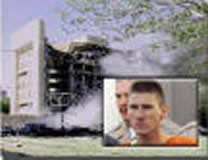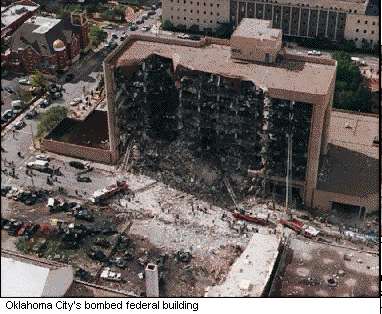|
Sometimes survival is a matter of blind luck.
That was clearly true for at least a few people who were
in the  Alfred.
P. Murrah Federal Building in Oklahoma City one fateful
day. They just happened to be in the right spot at the precise
moment when a bomb went off in the building at 9:02 A.M.
on April 19,1995. Some people survived because they went
to the bathroom or strolled
over to the coffee machine or visited a friend down the
hall. Alfred.
P. Murrah Federal Building in Oklahoma City one fateful
day. They just happened to be in the right spot at the precise
moment when a bomb went off in the building at 9:02 A.M.
on April 19,1995. Some people survived because they went
to the bathroom or strolled
over to the coffee machine or visited a friend down the
hall.
Brian Espe couldn't believe his good fortune. At first,
thinking the noise was an earthquake, he dove under his
desk. When he got up to look around, everyone else was gone.
The adjacent
offices had crashed through the floor and landed several
floors below. "MY surviving," Espe later said,
"was nothing short of a miracle."
The monstrous
explosion sliced the top of the federal building in half.
People on one side lived while most of those on the other
side tumbled
several stories to their deaths in the rubble
below. A secretary lived because she happened to be away
from her desk. One man's life was saved because he had gone
to the bathroom nobody else in his office was so lucky.
Another man was spared because he left his office moments
before the blast.
Other people survived only through the heroic efforts
of firefighters,
nurses, doctors, off-duty police officers, and paramedics
who rushed to the scene to help. One person they saved was
a 20-year-old woman named Dana Bradley. Rescuers found her
crying in the rubble with the lower half of her leg pinned
under tons of steel-reinforced concrete. She was trapped
in a space so small doctors couldn't reach her. For two
hours the doctors tried to figure out a way to save Bradley.
Twice they had to flee the area for fear of another explosion
or collapsing debris. "Please don't leave me!"
She pleaded
each time.
As time passed, it was clear something had to be done.
Bradley was in bad shape: her blood pressure was dropping,
and she was in the early stages of shock. Finally, the doctors
decided to risk cutting away some of the steel-reinforcing
rods that trapped her. That attempt could have caused a
further collapse, perhaps killing Bradley and the doctors.
Luckily, though, the cuts were made without mishap.
Even with the cut rods, however, there was still only
enough room for one doctor, crawling on his hands and knees
in about a foot of water, to reach Bradley. It was then
that Bradley heard the doctors' grim
assessment
of her situation. They would have to cut off her lower leg
if they were going to save her life. Bradley begged them
to think of something else. But there were no other options.
She screamed as the doctor removed her leg with a surgical
saw and scissors but, at last, the doctors were able to
pull her out of the building.
Later, Dana Bradley received more tragic news. Not only
had she lost a leg in the explosion, she had also lost her mother and two children. They were among the 168 people
who died in the bombing. Another 500 people were injured
by falling glass, concrete, and other debris. One man was
pierced in one hundred places by shards
of glass. Doctor Richard Crook treated several people suffering
from slashed throats and punctured
lungs. "We saw ruptured
eyeballs and rib fractures,"
he said. "One man was driving by the building when
the bomb went off and had his windows open. It ruptured
his eardrums."
her mother and two children. They were among the 168 people
who died in the bombing. Another 500 people were injured
by falling glass, concrete, and other debris. One man was
pierced in one hundred places by shards
of glass. Doctor Richard Crook treated several people suffering
from slashed throats and punctured
lungs. "We saw ruptured
eyeballs and rib fractures,"
he said. "One man was driving by the building when
the bomb went off and had his windows open. It ruptured
his eardrums."
The bomb did not discriminate
between rich and poor, white and black, or young and old.
The dead ranged in age from four months to 73 years old.
The tales of individual grief, like that of Dana Bradley,
pulled at the nation's heartstrings.
There was one image that truly captured the horror of
this catastrophe. It was the photograph of firefighter Chris
Fields emerging from the smoldering
ruins with the lifeless body of one-year-old Baylee Almon
in his arms. The little girl had just celebrated her birthday
the day before. Her mother, Aren Almon, had dropped Baylee
off at the second-floor day care center. When she first
heard the blast, Aren thought it might be a clap of thunder.
But then she saw it was the federal building. "We heard
that they had found a baby with yellow booties,"
she said, "and I knew it was her."
The day care center took the full force of the explosion.
Nineteen children in the nursery died. A few children, who
somehow lived through the bombing, were found dazed
and wandering about, crying frantically
for their parents. Rescuers found severel limbs scattered
among the toys and dolls. Some rescuers couldn't bear to
look down at the children they cradled
in their arms. One of the young victims had been decapitated;
others were burned beyond recognition.
The sight of those children stunned everyone. Robert Buckner,
a paramedic, expressed the outrage that most Americans felt.
"It's all a nightmare," he said. "But the
kids? Why anyone would want to do this to a place with a
day care center is beyond comprehension."
One of the rescuers spotted Oklahoma Governor Frank Keating,
who had rushed to the scene to offer his support. "Find
out who did this," the rescuer begged Keating. That
desire was shared by all American. Along with the devastating
grief, there was blind rage. Who could do such a thing?
The basic facts of the bombing soon became apparent. Somebody
had parked a Ryder rental truck next to the Murrah Building.
The innocent-looking truck contained 4,000 pounds of high
explosives. The blast from these explosives was so powerful
that it was felt 30 miles away. Some people in outlying
towns such as Guthrie and Chandler thought it was a sonic
boom. The bomb blew a crater
30 feet across and 8 feet deep in Northwest Fifth Street
and sent a red-orange fireball into the sky. Cars parked
along the street exploded. The explosion was so powerful
that it killed two people in a building across the street
At first, many people assumed that the bombing was the
work of foreign terrorists. But it wasn't. In this case,
the terrorists were homegrown Americans. The man who actually
drove the Ryder truck and set off the bomb was Timothy McVeigh,
a bitter loner
with a grudge
against the U.S. government. Apparently he thought killing
innocent men, women, and children was a good way to create
a better world. McVeigh was later arrested, convicted, and
sentenced to death. Another man, Terry Nichols, was also
arrested and convicted for his part in planning the bombing.
The Oklahoma City bombing was the worst case of domestic
terrorism in the history of the United States. The senseless
death of 168 people will not soon be forgotten. And people
were outraged by the number of orphans
created by the bombing. Ten children lost both their parents
in the blast. More than 150 young people under the age of
23 lost a parent. Suck wounds never really heal.
↑TOP (1,183
words)
|